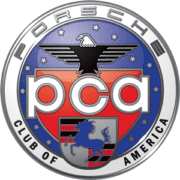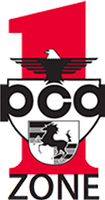2016 PORSCHE PARADE
By Sue Smith
On Friday, June 17, I left New Jersey to enjoy the drive up to Vermont for my first Porsche Parade. I know many beautiful roads from the days when Dale and I used to go hiking frequently, leaf touring, and cross-country skiing in Vermont, so I wanted to take the time to enjoy driving the 914 on some of these roads, including route 100, and also stop for a couple of short hikes to familiar waterfalls. Arriving on Sunday morning, while going through Parade registration, I enjoyed meeting many old friends, some of whom I hadn’t seen in quite some time. I had been considering going to Parade this year because it was within reasonable driving distance and in an area that I like very much, although I had not been as far north as Jay Peak in several years. I made the decision to go when longtime friend Peter Schneider asked me to be his driver for the TSD rally on Tuesday and share a condo with him and his wife, Joanne. I discovered that Peter had already checked in at rally registration and was very pleased that he had chosen a start time in the last half hour (between 9:30 and 10:00 a.m.). It can be a disadvantage to be one of the last cars to leave if you get behind slower rally traffic, but 7:30 a.m. was just too early for me! Shortly thereafter he called me to say that he and Joanne had checked into the condo and I left registration to meet them for lunch.
After attending the rally meeting on Monday, we had the feeling that this was going to be a complicated rally. But it turned out that a lot of what was discussed in the meeting was not used on the rally. Peter and I had practiced for this rally by competing in the Zone 1 rally, so I could become familiar with running with a rally computer. This is very different from the seat of pants rallying that Dale and I had done years ago, sometimes running trap rallies that Peter had written. For TSD rallies, I was the driver. We had a reader board mounted in the car so that I could glance at the route instructions to refresh my memory, keep us at the right speed and, for the most part, on the right course. Dale was very quick with math, and he kept us on time, and would let me know if I needed to speed up or slow down, as we both watched for signs and objects along the way.
For the Parade rally, I needed to keep us on time by keeping a close watch on the driver’s computer display, which showed whether we were early or late, what speed I was going, and the current rally speed (CAST). Peter read the instructions and programmed the timing information into the computer, making adjustments for pauses, gains, and the frequent speed changes. Sometimes I would look at the computer and suddenly we were ahead of time because Peter had programmed in a pause that I was unaware of. I did my best to keep the time on the display as close to zero as possible, or slightly ahead to allow for unexpected slowdowns. It is easier to quickly lose a little time than to gain it when anticipating a possible checkpoint. We both watched for the signs and landmarks along the way. Most TSD rallies are run in hundredths of a minute, but the Parade rally has changed to using
tenths of a second. Initially this was frustrating to Peter because he had to change the computer settings to an unfamiliar mode.
We ran the Parade rally in Peter’s 968 cab. The 968 was easy and fun to drive, although I had to get used to not shifting, and just using the “manual mode” of the automatic when I needed the torque for the hills. The route used many beautiful roads off Vermont routes 100, 101, and 105, in the Northeast Kingdom region which were enjoyable to drive. We ran very close to the Canadian border, but never went into Canada.
Given the varied experience of rallyists from so many different regions, the rally in general seemed complicated. It was a very busy rally, with a lot to look for all at once and things coming up very quickly. There was no time in the beginning to settle into a rhythm. At the very beginning of leg 1 was a confusing ‘Y’ intersection, which we missed while following the lined (main) road. We soon realized that something was not right when we approached the covered bridge from the wrong direction, made obvious from the position of the photographer. So we went back to the restart and found the correct route. We saw several rallyists pulled over, presumably also confused. A good tip in this situation is to go back to where you knew you were last on course and redo the instructions. Most TSD events give time allowances, as this one did. It is safer to take one than to try to make up the lost time.
Throughout the rally were “overlap instructions”, where one needed to go a specified distance before executing an ‘a’ or ‘b’ or an ‘or’ instruction. These were usually speed changes or pauses. If you executed these optional instructions before you had gone the specified distance in the instruction you were executing, you would end up early or late. Also used throughout the route instructions were signs or landmarks which only needed to be observed – you passed them with no action required. One also had to be careful when executing an ‘or‘ instruction – the route instruction on either side of the ‘or‘ was an independent instruction. An example of both scenarios was: “West Hill Rd” or “Hill West Rd” CAST 40. At first glance it might seem that you would CAST 40 at whichever sign existed or came up first, but in reality “West Hill Rd” stands alone as an observation, and since it was the correct sign, there was no speed change.
Near the end of the rally was a sign “North Hill Barn” on a barn. In the general instructions it said do not use signs on buildings. This is not a common sign rule in rallying because buildings are generally considered “permanent”, so we missed this. We executed the speed change at that sign, the only trap we fell for in the event. Fortunately, it was a small speed change, but it did result in a double-digit score for that leg.
Peter and I approach rallying quite differently. I will always do my best to win, but enjoying the rally challenges and scenic route are most important to me. Peter, on the other hand, wants to win!
Nevertheless, we had a great time running the rally together. During the rally I thought we were doing well, but there were many good rally teams that it was quite a surprise to me to come in first overall.
The rally awards banquet on Wednesday evening was also a good time, with good food and conversation. If we could just do without all of the publicity….. Peter was awarded the Woolery Memorial Rally Navigator Award, which is given to the Parade navigator of the automobile with the lowest score in the rally. This award has been presented in memory of W. F. “Bill” Woolery since the 1961 Parade.
I was awarded the Hoffman Rally Trophy, which is given to the Parade driver of the automobile with the lowest score in the rally. This award was created to honor Max Hoffman of the Max Hoffman Motor Car Company, the original distributor of Porsche cars in the U. S. Both trophies are large cups that the driver and navigator keep for a year and then return to be awarded again at the next Parade. We were each given a ‘keeper trophy’ for these awards, appropriately shaped like a mountain peak, in addition to the first place ‘in class’ awards.


